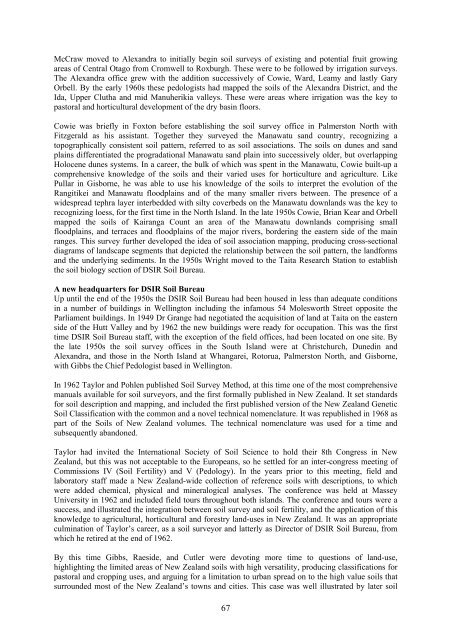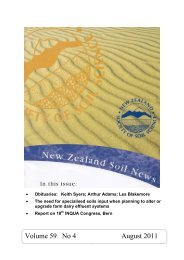Volume 55 No 2 April 2007 - New Zealand Society of Soil Science
Volume 55 No 2 April 2007 - New Zealand Society of Soil Science
Volume 55 No 2 April 2007 - New Zealand Society of Soil Science
You also want an ePaper? Increase the reach of your titles
YUMPU automatically turns print PDFs into web optimized ePapers that Google loves.
McCraw moved to Alexandra to initially begin soil surveys <strong>of</strong> existing and potential fruit growing<br />
areas <strong>of</strong> Central Otago from Cromwell to Roxburgh. These were to be followed by irrigation surveys.<br />
The Alexandra <strong>of</strong>fice grew with the addition successively <strong>of</strong> Cowie, Ward, Leamy and lastly Gary<br />
Orbell. By the early 1960s these pedologists had mapped the soils <strong>of</strong> the Alexandra District, and the<br />
Ida, Upper Clutha and mid Manuherikia valleys. These were areas where irrigation was the key to<br />
pastoral and horticultural development <strong>of</strong> the dry basin floors.<br />
Cowie was briefly in Foxton before establishing the soil survey <strong>of</strong>fice in Palmerston <strong>No</strong>rth with<br />
Fitzgerald as his assistant. Together they surveyed the Manawatu sand country, recognizing a<br />
topographically consistent soil pattern, referred to as soil associations. The soils on dunes and sand<br />
plains differentiated the progradational Manawatu sand plain into successively older, but overlapping<br />
Holocene dunes systems. In a career, the bulk <strong>of</strong> which was spent in the Manawatu, Cowie built-up a<br />
comprehensive knowledge <strong>of</strong> the soils and their varied uses for horticulture and agriculture. Like<br />
Pullar in Gisborne, he was able to use his knowledge <strong>of</strong> the soils to interpret the evolution <strong>of</strong> the<br />
Rangitikei and Manawatu floodplains and <strong>of</strong> the many smaller rivers between. The presence <strong>of</strong> a<br />
widespread tephra layer interbedded with silty coverbeds on the Manawatu downlands was the key to<br />
recognizing loess, for the first time in the <strong>No</strong>rth Island. In the late 1950s Cowie, Brian Kear and Orbell<br />
mapped the soils <strong>of</strong> Kairanga Count an area <strong>of</strong> the Manawatu downlands comprising small<br />
floodplains, and terraces and floodplains <strong>of</strong> the major rivers, bordering the eastern side <strong>of</strong> the main<br />
ranges. This survey further developed the idea <strong>of</strong> soil association mapping, producing cross-sectional<br />
diagrams <strong>of</strong> landscape segments that depicted the relationship between the soil pattern, the landforms<br />
and the underlying sediments. In the 1950s Wright moved to the Taita Research Station to establish<br />
the soil biology section <strong>of</strong> DSIR <strong>Soil</strong> Bureau.<br />
A new headquarters for DSIR <strong>Soil</strong> Bureau<br />
Up until the end <strong>of</strong> the 1950s the DSIR <strong>Soil</strong> Bureau had been housed in less than adequate conditions<br />
in a number <strong>of</strong> buildings in Wellington including the infamous 54 Molesworth Street opposite the<br />
Parliament buildings. In 1949 Dr Grange had negotiated the acquisition <strong>of</strong> land at Taita on the eastern<br />
side <strong>of</strong> the Hutt Valley and by 1962 the new buildings were ready for occupation. This was the first<br />
time DSIR <strong>Soil</strong> Bureau staff, with the exception <strong>of</strong> the field <strong>of</strong>fices, had been located on one site. By<br />
the late 1950s the soil survey <strong>of</strong>fices in the South Island were at Christchurch, Dunedin and<br />
Alexandra, and those in the <strong>No</strong>rth Island at Whangarei, Rotorua, Palmerston <strong>No</strong>rth, and Gisborne,<br />
with Gibbs the Chief Pedologist based in Wellington.<br />
In 1962 Taylor and Pohlen published <strong>Soil</strong> Survey Method, at this time one <strong>of</strong> the most comprehensive<br />
manuals available for soil surveyors, and the first formally published in <strong>New</strong> <strong>Zealand</strong>. It set standards<br />
for soil description and mapping, and included the first published version <strong>of</strong> the <strong>New</strong> <strong>Zealand</strong> Genetic<br />
<strong>Soil</strong> Classification with the common and a novel technical nomenclature. It was republished in 1968 as<br />
part <strong>of</strong> the <strong>Soil</strong>s <strong>of</strong> <strong>New</strong> <strong>Zealand</strong> volumes. The technical nomenclature was used for a time and<br />
subsequently abandoned.<br />
Taylor had invited the International <strong>Society</strong> <strong>of</strong> <strong>Soil</strong> <strong>Science</strong> to hold their 8th Congress in <strong>New</strong><br />
<strong>Zealand</strong>, but this was not acceptable to the Europeans, so he settled for an inter-congress meeting <strong>of</strong><br />
Commissions IV (<strong>Soil</strong> Fertility) and V (Pedology). In the years prior to this meeting, field and<br />
laboratory staff made a <strong>New</strong> <strong>Zealand</strong>-wide collection <strong>of</strong> reference soils with descriptions, to which<br />
were added chemical, physical and mineralogical analyses. The conference was held at Massey<br />
University in 1962 and included field tours throughout both islands. The conference and tours were a<br />
success, and illustrated the integration between soil survey and soil fertility, and the application <strong>of</strong> this<br />
knowledge to agricultural, horticultural and forestry land-uses in <strong>New</strong> <strong>Zealand</strong>. It was an appropriate<br />
culmination <strong>of</strong> Taylor’s career, as a soil surveyor and latterly as Director <strong>of</strong> DSIR <strong>Soil</strong> Bureau, from<br />
which he retired at the end <strong>of</strong> 1962.<br />
By this time Gibbs, Raeside, and Cutler were devoting more time to questions <strong>of</strong> land-use,<br />
highlighting the limited areas <strong>of</strong> <strong>New</strong> <strong>Zealand</strong> soils with high versatility, producing classifications for<br />
pastoral and cropping uses, and arguing for a limitation to urban spread on to the high value soils that<br />
surrounded most <strong>of</strong> the <strong>New</strong> <strong>Zealand</strong>’s towns and cities. This case was well illustrated by later soil<br />
67










